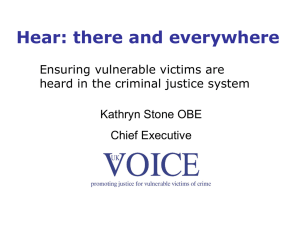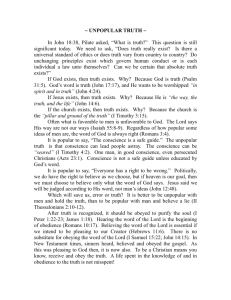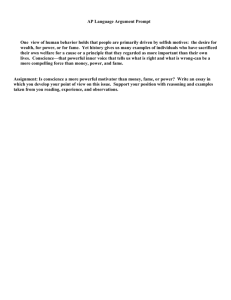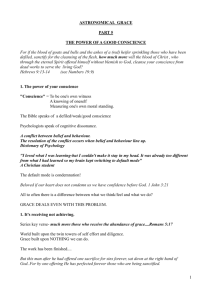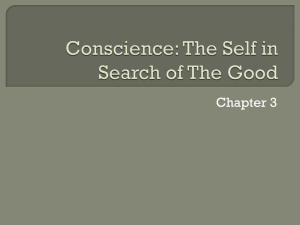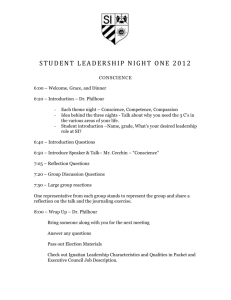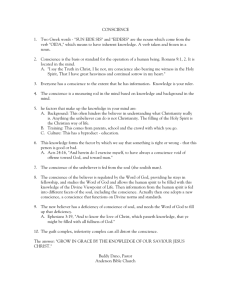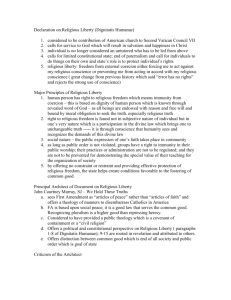here - International Center for Law and Religion Studies
advertisement
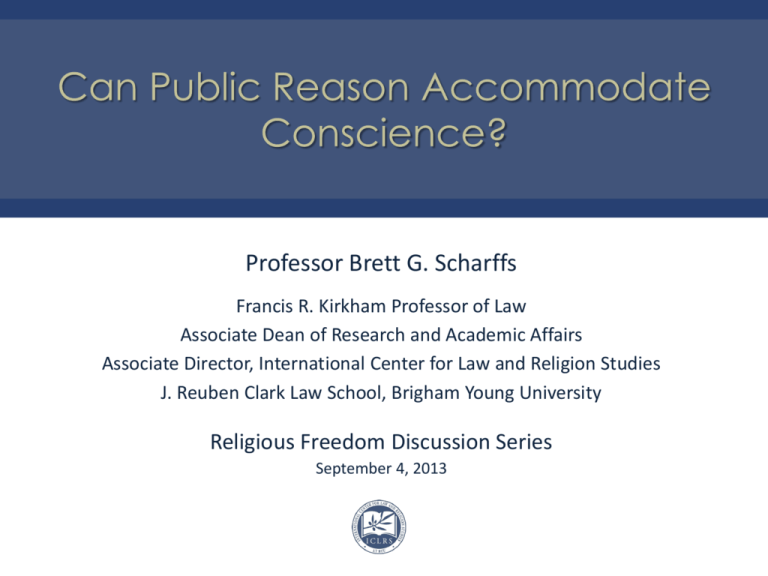
Professor Brett G. Scharffs Francis R. Kirkham Professor of Law Associate Dean of Research and Academic Affairs Associate Director, International Center for Law and Religion Studies J. Reuben Clark Law School, Brigham Young University Religious Freedom Discussion Series September 4, 2013 ◊ Public reason as a framework for political dialogue has come to have a force in American and European political thought that might have come as a surprise even to its most articulate contemporary defender, John Rawls. ◊ But as religious and other minority or dissenting voices are increasingly pushed to the margins of public discourse a serious philosophical, political, and practical question has arisen about the extent to which public reason can accommodate claims of conscience. The basic problem can be presented starkly: ◊ If public reason rules as inadmissible reasons that are not publicly accessible, is there any reason to respect conscience at all, since by its very nature the claims of conscience may be private and only partially accessible or explicable? ◊ If public reason reigns supreme as a model of public discourse, are claims of conscience doomed? The high-water mark for the protection of conscience in U.S. Supreme Court jurisprudence may have come in the World War II - era Pledge of Allegiance case, West Virginia State Board of Education v. Barnette (1943). In holding that patriotic observances must not be compulsory, the Court in West Virginia v. Barnett (1943) said, “We apply the limitations of the Constitution with no fear that freedom to be intellectually and spiritually diverse or even contrary will disintegrate the social organization.” Freedom to differ, “is not limited to things that do not matter much. That would be a mere shadow of freedom. The test of its substance is the right to differ as to things that touch the heart of the existing order.” Justice Jackson: “If there is any fixed star in our constitutional constellation, it is that no official, high or petty, can prescribe what shall be orthodox in politics, nationalism, religion, or other matters of opinion or force citizens to confess by word or act their faith therein.” West Virginia State Board of Education v. Barnette, 319 U.S. 624 (1943) Only three years earlier, the Court had reached the opposite conclusion in Minersville School District v. Gobitis. By an 8–1 margin, the Supreme Court decided against the Jehovah’s Witnesses conscientious objectors and for the School District. Citing the values of uniformity, patriotism, and equality to justify compelling students to participate in reciting the Pledge of Allegiance, Justice Felix Frankfurter wrote for the Court: “Conscientious scruples have not, in the course of the long struggle for religious toleration, relieved the individual from obedience to a general law not aimed at the promotion or restriction of religious beliefs. The mere possession of religious convictions which contradict the relevant concerns of a political society does not relieve the citizen from the discharge of political responsibilities. The necessity for this adjustment has again and again been recognized.” Minersville School District v. Gobitis, 310 U.S. 586 (1940) Perhaps most significantly, Justice Frankfurter cited the importance of the values weighing against the Gobitis children’s free exercise and due process rights: “We are dealing with an interest inferior to none in the hierarchy of legal values. National unity is the basis of national security.” Whereas Barnette may be our most eloquent defense of religious conscience, Gobitis is an equally unwavering plea on behalf of public reason, invoking values like national unity, national security, the inculcation of patriotism, equality, and the idea that religious scruples could not justify disobedience to a general law. A. The United States i. Cases involving the Defense of Marriage Act and Proposition 8. ii. Christian club must accept all comers, not just as members, but as leaders, on the grounds that religious standards are discriminatory. iii. County clerks losing jobs due to refusal to perform same-sex marriages, even when other clerks in the same office could provide the service. iv. Religiously affiliated adoption clinics shutting down rather than submitting to demands to facilitate same-sex couple adoptions. v. Pharmacists losing their jobs because of their conscience-based refusal to fill prescriptions for contraceptive or abortifacient drugs. vi. Employers being denied an exemption from Obamacare rules requiring their insurance plans to cover contraceptives and morning-after pills. vii. A wedding photographer being found in violation of antidiscrimination laws for declining to photograph a same-sex wedding. viii. Courts forcing an Amish girl to receive chemotherapy against her wishes. ix. Dartmouth College bishop being fired over his views on homosexuality. x. Legislative proposal in California would deny tax exempt status to organizations such as Little League and the Boy Scouts, due to their allegedly discriminatory policies. B. Europe i. In cases from England involving religious conscience, the European Court of Human Rights sends mixed signals: a. upholding the right of a British Airways employee (Nadia Eweida) to wear a small cross at work, b. but denying a similar right on grounds of hygiene and safety to a geriatrics nurse (Shirley Chaplin) who had worn a small crucifix necklace for thirty years, c. upholding the dismissal of a therapist (Gary McFarlane) who objected to counseling same-sex couples, d. and denying the claim of a marriage registrar (Lillian Ladele) who objected to conducting civil same-sex partnership ceremonies. ii. In Ireland, doctors being forced to provide abortions despite their conscientious objections. iii. Turkey admitting having secret identity codes for religious minorities. iv. Kazakh Baptists being fined for worship meetings. v. Same-sex couples suing the Church of England for marriage rights. vi. In Russia, religious groups, texts, activities falling under the condemnation of new “extremism” laws. A. John Rawls B. Kent Greenawalt C. Bruce Ackerman “To begin: in a democratic society public reason is the reason of equal citizens who, as a collective body, exercise final political and coercive power over one another in enacting laws and in amending their constitution. In other words, political power is by its nature “coercive” and “final,” and when we as citizens exercise power over each other, we have an obligation – a moral obligation, an obligation of civility – to only exercise such coercive power pursuant to reasons that our fellow citizens can reasonably be expected to accept or endorse. In order for the exercise of political power to be legitimate in a liberal democracy, says Rawls, it must be exercised pursuant to the limitations imposed by public reason. John Rawls The content of public reason is based upon what Rawls calls a “political conception of justice” that is broadly liberal in character. This political conception of justice has three features: 1. A specification of basic rights, liberties, and opportunities. 2. These rights, liberties and opportunities have a special priority as against teleological or general claims. 3. Citizens are empowered with the means of making effective use of these basic liberties. Columbia University law professor Kent Greenawalt explains the power and appeal of public reason in his book, Religious Convictions and Political Choice, where he identifies public reason as reason that rests on “shared premises and publicly accessible reasons.“ As Greenawalt explains, “The clearest instances of judgments based on publicly accessible reasons are ones based on reasons whose force, rather than being a product of the particular persons making the judgments, would be acknowledged by any competent and levelheaded observer. . . . “Religious morality and religiously grounded moral judgments” are “beyond shared premises and publicly accessible reasons.” Kent Greenawalt Religion does not have an appropriate place in the public realm of a liberal democracy. The principles of justice result from a conversation among citizens, and for the conversation to yield determinate outcomes the permissible arguments must satisfy the condition of neutrality, which binds legitimate states to adopting a particular conception of equality, to toleration, and to individual rights. The social contract is the contract that would be confirmed by the entire population, under ideal conditions, after perfect and complete consideration. Bruce Ackerman If we translate our “real” reasons into “public” reasons, there is doubt that we are being completely candid about why we believe what we advocate. ◊ For example, when secular reasons are given in opposition to abortion rights or gay marriage, audiences (and especially opponents) question the sincerity of these reasons. ◊ The “real” objection, they suspect, is religious; religious reasons, they contend, don’t count; and so the translated “secular” reasons are discounted, suspected, or treated as being disingenuous. ◊ Giving our real reasons in public, this objection maintains, is what should count as “public reason,” not hiding them behind reasons that might be more secular. Another objection to public reason focuses on what are and are not legitimate forms of persuasion. ◊ Rhetoric, as understood and defended by Aristotle, Cicero, and others, is subject to limitations in order for it to be legitimate. ◊ In a democracy, if a reason is found persuasive to a majority of voters (or legislators), we might say it qualifies as a “public reason.” If something persuades the public, this argument goes, it is a public reason. ◊ This is not to say that anything goes, but the limits that apply to moral rhetoric would apply, rather than a separate set of moral norms to govern “political discourse.” A third objection is that reasons are legitimate if they are true. Rawls strenuously argues against the “whole truth” argument. To say that reasons are not “publicly assessable” if they are not accepted by everyone who is reasonable, goes too far. One critique of public reason anticipated by Rawls is that much of the most important and persuasive political rhetoric in American history has been overtly religious, including the reasons of abolitionists who opposed slavery, and advocates of civil rights, such as Martin Luther King. 1. Inclusive Public Reason Rawls says that the overtly religious political rhetoric in American history does not violate public reason, because although the viewpoints may have been expressed in religious language, they could have been translated into more secular, neutral terms that comports with the standards of public reason. ◊ Rawls concedes that abolitionists based their arguments on religious grounds; however, “the nonpublic reason of certain Christian churches supported the clear conclusions of public reason.” ◊ The same, Rawls says, is true of Martin Luther King, who also made “public reason” arguments based Supreme Court cases such as Brown v. Board of Education – “to the political values expressed in the Constitution correctly understood.” upon 1. Inclusive Public Reason To cite another example, Abraham Lincoln in his second inaugural address was not simply expressing political values – freedom and equality for all – in terms of religious language, his speech was a sincere meditation on God’s purposes in allowing the Civil War to last so long and to exert such a toll on both north and south. Rawls argues for an “inclusive” attitude towards comprehensive doctrines (including religion), provided it is done in “ways that strengthen the ideal of public reason itself. “ But this argument is rather too convenient, and can easily degenerate into approbation of religious speech that aligns with one’s preferred political positions, and condemnation of religious speech that does not align with one’s preferred political positions. 2. Abortion What Rawls has to say about abortion is instructive. He does not treat religious opposition to abortion as compatible with public reason, and seems to believe that efforts to translate opposition to abortion is either disingenuous or dishonest disguising of religious preferences. He suggests that the question of abortion implicates three important political values: 1. The due respect for human life. 2. The ordered reproduction of political society over time, including the family in some form. 3. The equality of women as equal citizens. Rawls then asserts . . . “[A]ny reasonable balance of these three values will give a woman a duly qualified right to decide whether or not to end her pregnancy during the first trimester. . . . [A]t this early stage of pregnancy the political value of the equality of women is overriding, and this right is required to give it substance and force. Other political values, if tallied in, would not, I think, affect this conclusion. A reasonable balance may allow her such a right beyond this . . . . However, I do not discuss the question in general here, as I simply want to illustrate the point . . . that any comprehensive doctrine that leads to a balance of political values excluding that duly qualified right in the first trimester is to that extent unreasonable; and . . . it may also be cruel and oppressive; for example, if it denied the right altogether except in the case of rape and incest.” Rawls concludes that denying abortion rights “would go against the ideal of public reason” and that any comprehensive policy that does not support first trimester abortion rights is unreasonable. 3. The U.S. Supreme Court Marriage Decisions a. Justice Anthony Kennedy’s Majority Opinion in Windsor b. Justice Antonin Scalia’s Dissent in Windsor c. Public Reason in the DOMA Case In the June 26, 2013 decision in United States v. Windsor Justice Kennedy (joined by Justices Ginsburg, Breyer, Sotomayor, and Kagan) found that the definition of marriage as a union between one man and one woman in Section 3 of the Federal Defensive of Marriage Act (DOMA) is an unconstitutional violation of the Due Process Clause of the Fifth Amendment. Justice Kennedy begins the key section of his opinion (Part IV) with a broad declaration: “DOMA seeks to injure the very class New York seeks to protect.” He goes on to say that the law was motivated by a “desire to harm a politically unpopular group” and suggests the law was motivated by an “improper animus or purpose.” He says the “essence” of DOMA was to “interfere[] with the equal dignity of same sex marriages.” Justice Kennedy cites with approval, and as his primary evidence of animus, language from the House report: “The House concluded that DOMA expresses ‘both moral disapproval of homosexuality, and a moral conviction that heterosexuality better comports with traditional (especially Judeo-Christian) morality.” Justice Scalia pulls no punches in his dissent, calling out the majority for its attribution of motives to the legislators (85 percent of the Senate and 84 percent of the House) and President (Bill Clinton) who enacted DOMA. Complains Scalia, “The majority says that the supporters of this Act acted with malice – the ‘purpose to disparage and to injure’ same-sex couples. It says that the motivation for DOMA was to ‘demean’; to ‘impose inequality’; to ‘impose . . . a stigma’; to deny people ‘equal dignity’; to brand gay people as ‘unworthy’; and to ‘humiliate’ their children.” Says Justice Scalia, “To be sure (as the majority points out), the legislation is called the Defense of Marriage Act. But to defend traditional marriage is not to condemn, demean, or humiliate those who would prefer other arrangements, any more than to defend the Constitution of the United States is to condemn, demean, or humiliate other constitutions. To hurl such accusations so casually demeans this institution. In the majority’s judgment, any resistance to its holding is beyond the pale of reasoned disagreement.” “In the majority’s telling, this story is black-and-white: Hate your neighbor or come along with us. The truth is more complicated. It is hard to admit that one’s political opponents are not monsters, especially in a struggle like this one, and the challenge in the end proves more than today’s Court can handle. Too bad. A reminder that disagreement over something so fundamental as marriage can still be politically legitimate would have been a fit task for what in earlier times was called the judicial temperament. We might have covered ourselves with honor today, by promising all sides of this debate that it was theirs to settle and that we would respect their resolution. We might have let the People decide.” ◊ Smith is often cited as the most damaging judicial opinion of the last 50 years to religious freedom rights. Windsor may have an even stronger claim for its wholesale dismissal of religion. ◊ Religious opposition to gay marriage is sweepingly dismissed as being motivated exclusively by “animus,” and all non-religious reasons are dismissed as being pretextual concealments of religious bias. ◊ Not only are religious reasons comprehensively dismissed; expressing such opposition in terms of public reason is completely dismissed as well. Religious conscience is dismissed as nothing more than illegitimate animus. In understanding the trajectory of the role of public reason in political discourse, and the prospects for claims of conscience surviving in a political culture in which public reason is the dominant conception of acceptable political and legal reasoning, it is helpful to understand something about the genesis of the idea of public reason, and the stark clarity with which its implications for conscience were originally understood. The concept of public reason was not invented by Rawls, or even Immanuel Kant (to whom it is often traced, including by Rawls). It was Thomas Hobbes, writing a hundred years before Kant, in Leviathan, who introduced the idea. As Kant did a century later, Hobbes contrasted public reason with “private reason,” which was identified with claims of conscience. For Hobbes, public reason was the will of the sovereign (and nothing more): It was the reason given by the King or Parliament (representing the public), as opposed to reasons given by subjects (private reasons). As Yale Political Science Professor Bryan Garsten has explained, Hobbes wrote in large measure in response to the “Puritan rhetoric of conscience,” the defense of “private judgment” and conscience” that were “the regular form of public preaching among the Puritan ministers so important to seventeenth-century politics in England.” These Puritan preachers asserted that such claims of conscience were inviolable, even if public authority demanded otherwise. Hobbes viewed such appeals as subversive and likely to be used to incite sedition. For Hobbes, claims of conscience were no more than private judgments that were seeking special status. In Hobbes’s understanding of the state, individuals agreed to be governed by the Sovereign as a way of escaping the state of nature (the “war of all against all”), where life, in his memorable description, is “solitary, poor, nasty, brutish, and short.” Following the dictates of the omnicompetent sovereign, for Hobbes, vindicated conscience, since the individual had already consented to submit to political authority. As Professor Garsten explains, “a person who followed the Laws in a Hobbesian commonwealth was by definition acting according to the dictates of conscience, since he had transferred the right of determining ‘the public conscience’ to the sovereign: [in the words of Hobbes,] ‘The law is the public Conscience.’” The obligation to obey the sovereign lasts as long as the sovereign protects his subjects. As Hobbes put it: “The conscience being nothing else but a man’s settled judgment and opinion, when he hath once transferred his right of judging to another, that which shall be commanded, is no less his judgment, than the judgment of that other; so that in obedience to laws, a man doth still according to his conscience, but not his private conscience. And whatsoever is done contrary to private conscience, is then a sin, when the laws have left him to his own liberty, and never else.” For Hobbes, it was no sin to act contrary to conscience, provided this was at the direction of the sovereign. Ceding conscience to the sovereign in matters of public important also shields individuals from the preaching and prophesizing of those who claim to speak on behalf of God. “We have seen that when Hobbes devised his understanding of representation, he was asking citizens to disregard not only their own judgments and dictates of conscience but also, and perhaps more importantly, those judgments supplied to them by preachers and prophesiers. He asked citizens to protect themselves from the influence of these orators by chaining their ears to the lips of the sovereign, whose words he called the ‘public conscience’ and, in Chapter 37 of Leviathan, the ‘public reason.’ For the sake of peace, he argued, ‘the Private Reason must submit to the Publique.’ Public reason was thus created as a means of avoiding controversy by providing an external source of unified judgment. It sought to avoid the political tumult that resulted when each citizen was left to judge for himself and thus made prey to the influence of orators.” Bryan Garsten – Saving Persuasion: A Defense of Rhetoric and Judgment ◊ Hobbes warns against the “diseases of a commonwealth that proceed from the poison of seditious doctrine, whereof one is that every private man is judge of good and evil actions.” ◊ This may be true in the state of nature, but not in a commonwealth, where “the measure of good and evil actions is the civil law, and the judge the legislator, who is always representative of the commonwealth.” We would expect a Rawlsian liberal to object strongly to their understanding of public reason being linked with Hobbes’ sovereign Leviathan. Indeed, Rawls expressly denies that “aristocratic and autocratic regimes” exhibit public reason, because in such regimes it is “rulers” that consider the public good, if it is considered at all. Declares Rawls, “Public reason is characteristic of a democratic people: it is the reason of its citizens, of those sharing the status of equal citizenship. The subject of their reason is the good of the public: what the political conception of justice requires of society’s base structure of institutions, and the purposes and ends they are to serve.” But for Rawls, there are no analogous rights of freedom of conscience from the authority of the state short of renouncing one’s citizenship. As Rawls explains, in contrast with religious groups, where you can evade the institution’s authority, by withdrawing, “the government’s authority cannot be evaded except by leaving the territory over which it governs, and not always then.” Thus, if the state insists on forcing us to act in violation of our conscience, our options are limited – we can emigrate (and even that may not put us beyond the reach of the state’s jurisdiction). In the post-World War II years, the Supreme Court developed a test for assessing free exercise claims known as the compelling state interest test. When religion was burdened, there was a presumption that this was a violation of free exercise rights unless the state could prove that the limitation of freedom was justified by a compelling state interest and was achieved by the least restrictive means. But as is well known, the situation changed dramatically with the Court’s decision in Employment Division v. Smith (1990), which involved a conscientious objection claim for religious uses of the hallucinogenic drug peyote when ingested in Native American Church religious ceremonies. In Smith the Supreme Court articulated a new test for free exercise claims. A state law that burdens religious exercise does not violate the Free Exercise Clause as long as that burden is imposed through a general and neutral law. Can (and must) public reason respect claims of conscience? ◊ On one level the answer is clearly, “yes.” ◊ Political majorities, for reasons recognized by public reason, might agree to protect or accommodate conscience, including the conscience of minorities. ◊ Thus, for example, U.S. law has included provisions protecting conscientious objectors to military service. The question of whether public reason must (or can be expected) to accommodate conscience is much more problematic. Consider the basic form of reasoning that might fail to protect conscience: ◊ first, coercive legislation should be based upon public reasons; ◊ second, private reasons (such as religious convictions) do not count as public reasons and can therefore be discounted. This is what we might call the “public reason two-step.” This is not just a description of public reason as envisioned by Thomas Hobbes. Every conception of public reason – whether that of Hobbes, Kant, or Rawls – begins by differentiating between public reason and private reason, and by crediting the former and discrediting the latter. Thus, unless claims of conscience can be expressed persuasively in terms of public reason, they may not only be discounted, they may be disclaimed as illegitimate. B. Yale Law Professor Stephen L. Carter [Thanks to Galen Fletcher of our BYU Law Library for bringing Carter’s argument to my attention.] Carter notes that the government is much more protective of speech when it is unconnected with action, and when it is made ineffectively by individuals than when it is made effectively by institutions (such as religions). In a lecture given at Harvard in May 1995, Carter described the attitude about governmental limits on religion as follows: “Preach whatever you like, as long as you are unconvincing. . . . But if you are preaching about something serious, and if you begin to persuade others to act, why, then the state may stop you. And there lies the point: by protecting advocacy only until it moves people to act, the courts have drawn not simply a speech/action distinction, but an individual/group distinction. The lone critic is no danger, because he can do nothing alone. But the group, because it is better able to act, becomes a threat. That is why those in power have always sought legal means to thwart organizations that are preaching dissent; while leaving ineffective individuals largely alone. This allows us to proclaim a respect for free speech, leaving unspoken the corollary, that speech will be left free only as long as it is ineffective.” Where does a strong commitment to public reason lead? We have reason to worry that it may lead to the Liberal Leviathan – the tyranny not of Hobbes’s imperial sovereign, but the tyranny of imperious majorities (or perhaps overbearing judges), confident (even self-righteous) in the reasonableness of their own views, and with every reason (in their minds) to disparage and disregard claims of conscience by those who would dissent; such claims of conscience being ipso facto “unreasonable” because they do not satisfy the conditions of public reason. In dividing “reason” into “public reason” and “private reason,” and by treating the one as legitimate and the other as illegitimate, and by placing comprehensive religious systems of belief into the category of “private reasons,” public reason clears away the unruly underbrush of conscience in the service of building the shiny edifice of the Liberal Leviathan. Professor Brett G. Scharffs Francis R. Kirkham Professor of Law Associate Dean of Research and Academic Affairs Associate Director, International Center for Law and Religion Studies J. Reuben Clark Law School, Brigham Young University Religious Freedom Discussion Series September 4, 2013
